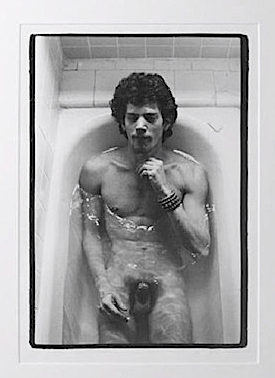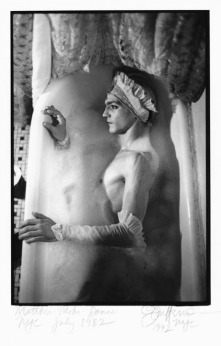What a difference a week makes! It has only been 10 days since my original article about Don Herron’s Tub Shots was posted to coincide with the opening of the Daniel Cooney Fine Art exhibit. The article was then re-posted on Queerclick, while Out magazine posted their own piece about the gallery exhibit, as did numerous art photography websites and blogs. Each time I do a Google search, I find more information about Don Herron and his series of photos, which had very little internet presence up to this point.

The digital skeleton of the Village Voice even resurrected their feature from April, 1980. This is curious, considering a) The paper had been declared officially dead two weeks ago, and b) One of the subjects in their 23 photo spread sued for invasion of privacy when it was published the first time, claiming that the model release form was forged.



Some alternate pics have surfaced of the ubiquitous Tub Shots featuring Keith Haring and Robert Mapplethorpe:



In a letter to a friend, Herron recalled; “I photographed Robert Mapplethorpe in San Francisco in February, 1978. He was having a show of photos at the Edward de Celle Gallery and we had met at his opening the night before.
“I was to photograph him at 3pm the next day in his hotel room, at at 3 Robert wasn’t in his room, so I waited in the lobby. At 3:15 he walked in and apologized: he had forgotten all about the shoot and was just getting in. As I photographed him in his bathtub he kept saying that he couldn’t remember much about his opening the night before or much about our conversation at the gallery, but if I was willing to photograph him in his current condition he was willing to pose.”
Daniel Cooney Fine Art posted several Instagram photos from the September 13th exhibit opening with original subjects standing next to their photos.
Left to right: Charles Busch, Agosto Machado and Michael Musto:



Here’s a little more info about some of the other luminaries featured in Tub Shots :
Robert Opel (1939-1979) was a conceptual artist, Advocate photographer and gay rights activist who achieved notoriety when he streaked through the 1974 Oscar Ceremony. He launched the first openly gay art gallery in San Francisco, where he was murdered in 1979. He is the subject of Uncle Bob, a 2011 documentary directed by his nephew Robert Oppel.

Actress Mink Stole is one of John Waters’ Dreamlanders and has appeared in all his films, most notably as Connie Marble in Polyester, Taffy in Female Trouble and Dottie Hinkle in Serial Mom. She also played Aunt Helen in all of the Eating Out films.

Cookie Mueller (1949-1989) was another John Waters Dreamlander who appeared many of his films, including Pink Flamingos and Desperate Living – her Tub Shot includes the poster for the latter. She also penned a column for The East Village Eye and half a dozen books.
Victor Hugo (1942-1993) was a Venezuelan artist, window dresser and nightlife personality. Hugo designed window displays for his partner Halston‘s Madison Avenue store. He later became one of Andy Warhol’s assistants at The Factory where he worked on the oxidation paintings. As a model, he also appeared in Warhol’s Torso and Sex Parts series.


As the different subjects recount how they got involved in the project, a thread emerges: Robert Mapplethorpe brought in Felice Picano, who in turn suggested Victor Hugo and George Stavrinos, who then connected Mel Odom. (Read part 1 of this post for more on them)
P eter Berlin‘s statement about Don Herron and his Tub Shots is exactly what you would expect from the legendary narcissist:
eter Berlin‘s statement about Don Herron and his Tub Shots is exactly what you would expect from the legendary narcissist:
“He may have approached me for sex and then asked to take my photo. I have no recollection of him or the photo shoot.
At the time, I never cared for photos taken by other photographers, not even Mapplethorpe’s photos of me. I realized how critical I was looking at my image, so I probably would have seen this photo and not liked it. Looking at the photo now, I don’t mind it. It’s not a typical Peter Berlin photo that I would have taken of myself. I like everything but the dick and my expression in the face. But I have no recollection at all of him or this shoot.”
The Daniel Cooney Fine Art exhibit with 65 of these photos at their gallery in New York City runs from September 13 until November 3, 2018. Contact the gallery for reservations via phone at 212-255-8158, via email dan@danielcooneyfineart.com or give them a visit at 508-526 West 26th St., #9C, NY NY.







Congratulations to the late Mr. Herron on this recent rediscovery of his work. As artist Adam Donaldson Powell posted in the comments of Part 1: “…he deserves due credit now. His other paintings and silk screen art were even more impressive than Tub Shots. I would love to see that work praised online as well.” We shall see…
See Also:
Don Herron’s Tub Shots Part I
Don Herron’s Tub Shots Part III
Don Herron’s Tub Shots Part IV: Christopher Street (1980)
Kenn Duncan After Dark
Gay Times #69 (1978)
Blueboy 1980: Gays of NYC
John Waters in Blueboy Magazine (1977)
New York City: In Touch For Men (1979)
Great work Brian! This was the Era of Art, AIDS and Activism. Not many know the history of this fascinating period in NYC and SF. I was truly fortunate to have been a part of it. Do you know Mapplethorpe’s ex-lover Jack Fritscher?
LikeLiked by 1 person
Thanks Adam! I appreciate your feedback and also the links to your blog. I don’t know Jack Fritscher but I read Some Dance To Remember many years ago. Does he live in New York?
LikeLike
Good morning Brian! Jack contacted me some years ago after I published my tribute to Don Herron on my main blog. He wanted to know who has the rights to Don’s Mapplethorpe portrait, as he was working on a new project about Robert Mapplethorpe. At that time he was still alive, and living in California. He has done very, very much excellent work as regards documentation of that time period — as well as of gay culture and Mapplethorpe. A real nice guy too! You will find a couple of links to his projects on my Mapplethorpe posting: https://adam-donaldson-powell.blog/2018/09/12/first-hour-on-a-new-painting-guess-who/
The reason I ask is that this period of art, AIDS and gay cultural development in NYC and SF is difficult to sum up — as is evident from the many who now comment that they can hardly remember things that transpired back then. This is not just because we are now “old”, but because it was a chaotic time where everything flowed together: personality as artistic expression, renaissance of ideas and artistic disciplines, underground celebrities who often met only once or a few times, and either on the streets, at parties or sex clubs, multidisciplinary and diffuse art forms whereby individual stunts and niches sometimes suddenly took hold, weekly/nightly disco nights with Warhol and other celebrities at places like Studio 54, Area, The Tunnel, drugs, drag queens and leather queens, outrageous sex clubs, drugs, punk rock, witchcraft as a lifestyle, etc. In short, it was (and is) difficult to separate the everyday occurrences from “the dream-state”. Many gays at that time were — like me — transformed “super hippies” who sunned ourselves in the sex clubs, the artistic stunts, new minimalistic theatre, dance and music forms, poetry at art galleries, building occupations, cross-dressing as an art form etc. Jack has (or had) tons of information, documentation and memories. Someone should really try to get deeper into the phenomenon of that period of time in NYC, SF, Paris etc. I mention a few aspects of it in my published novels and poetry but you seem like a great candidate to take on this task — while a few of us from then are still around/alive — and you who still live in NYC, and can link the years in between Tubshots, Mapplethorpe etc. to now.
It is all too easy for those of us who were a part of the “scenes” back then to glorify things. There were, in fact, lots of “downers” — especially with the AIDS crisis, drug overdoses etc. And only a few of us became very important in art history. But none of this could have happened without each and every one of us participating, interacting, encouraging, challenging, feeding on and feeding one another, in our artistic niches and outrageousness. We were unafraid — and at times a bit naïve. We were, basically, determined to live — for the moment; a glorious moment without recognisable start or ending. But we were also vulnerable human beings, full of emotional ups and downs, lives and wardrobes full of rags and glitter, forgotten sexual memoirs with now-famous persons who turned us on just because they were full of determination to express themselves in every way possible.
Don Herron was human, emotionally vulnerable, intelligent, very artistically gifted, unconventional, a cat-lover, one who met people in all social environments rather easily, he was very funny (referred to himself as a “Fred MacMurray-type” and loved “I Love Lucy”, tea and pies, and he had a very large cock and was fond of both sex and lots of cuddling. He was also at times more than a bit neurotic and could be intense — but no more than any of the rest of us. “Tubshots” was just one of his art expressions and ideas. His walls were adorned with murals of Roman lasciviousness, angels and cartoonish figures. His silk-screening, painting and other artworks were advanced for the time. Don Herron is just one of many from that time before modern internet who deserves a good-sized footnote through contemporary technology and art and gay history.
LikeLike